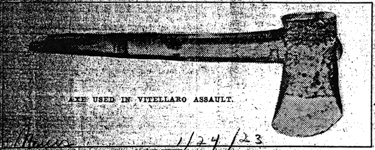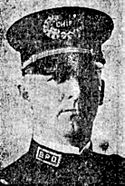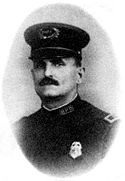Axe syndicate
The so-called axe syndicate was a group of people believed to have been responsible for a four-year spate of brutal killings which started in November 1919 and ended in October 1923.
Though no overall pattern connecting the crimes was established, they appeared to Birmingham Police Chief Fred McDuff to fall into at least two classifications. In many cases small shop owners, often foreign-born, were targeted in robberies, some of which were suspected of resulting from disputes between thieves and their fences. In another group of cases, police suspected retribution on behalf of presumed victims of miscegenation. The attacks on shop owners apparently ended after five African Americans were arrested in the winter of 1923–24.
Accounts of the number of crimes committed by the gang vary, as do the lists of people killed or wounded in their attacks. The New York Times reported there had been 24 killed in 44 attacks, while the Birmingham papers counted only 15 dead and 13 wounded attributable to the "syndicate".
Numerous arrests were made, and some convictions obtained in the attacks. Nevertheless, a public uproar rose in response to the frequent grisly attacks. Commissioner of Public Safety William Cloe made an "appeal to the people of Birmingham not to give way to hysteria over the recent axe murders," and continued denying the surge of pistol permits flooding his office. He did suggest that small merchants should consider closing earlier in the evenings. Sheriff Thomas Shirley also downplayed the story,
On December 11, 1923 an African American man, Fred Glover, was arrested on suspicion of attacking Mr & Mrs Edwin Sparks two days earlier. Glover, who had recently served time for burglary and grand larceny, was brought to the hospital and identified by Mrs Sparks as her attacker. A search of his home produced a short-handled blood-stained hatchet and a pistol.
Four more arrests followed on January 6, 1924: Peyton Johnson, John Reed, and O'Delle and Pearl Jackson. According to one account, police were led to a house where the group bragged to each other about their murderous deeds on a tip from a paid informant.
During interrogations, the Jacksons, Johnson and Glover were given doses of an experimental "truth serum" consisting of scopolomine and morphine. While under the influence of the drug mixture, they collectively confessed to eight of the murders. Those confessions were affirmed after the effects of the drug had worn off. Furthermore, Jefferson County Solicitor James Davis said that the suspects' statements included elements of some of the crimes which had not been made public.
Investigators, which included Jefferson County Sheriff Thomas Shirley and Paul Cole, Chief of Detectives in the Birmingham Police Department, came to describe a "syndicate" of murderers who drew straws for the privilege of attacking selected targets. A man named Garfield was alleged to have founded the syndicate, but had died of natural causes during 1922. Three members of the gang were presumed to remain at-large. By February, 10 suspects had been identified.
Interrogations
Glover and the group of people suspected of being leaders in the syndicate caught in 1924 were interrogated using an experimental "truth serum", a mixture of scopolamine and morphine, which was also given to pregnant women to ease delivery. The drug put the suspects into what was described as a "twilight sleep," during which they lacked the will to lie.
The interrogations were led by a local physician, given the fictitious name of "A. A. Goldberg" in press accounts. He prescribed a typical dosage of four ounces of the mixture. After a preliminary medical examination to screen for conditions that would make the drug dangerous, the drug would be delivered in increments by hypodermic needle or in capsule form. The subject would be told beforehand to remember a number, and asked to recall it periodically while the drug was administered. When the subject could no longer remember the number, he was considered to be ready for questioning. Interrogation was conducted in a darkened room, using bright lights to "recall the suspect to his senses". The usual methods of the "third degree", such as pushing, rough handling, slaps, kicks, curses, terrifying stage effects, and deprivation from food, drink, and sleep, would not be used. The drug was not found to be infallible, as many statements made by prisoners were deemed meaningless.
In February 1924, Davis reported that he was convinced of the effectiveness of the serum. He credited it with leading police to parties they did not initially suspect, but whose involvement was corroborated by the discovery of physical evidence in searches. He stated that "when criminals adopt an attitude of silence in the Jefferson County jail their tongues will be unlocked with this serum," which he predicted would become "generally used" over the next few years. He indicated that police from around the country had contacted him for more information about the use of scopolamine in criminal investigation.
On the other hand, Davis recognized that judges and juries remained skeptical. He did not use testimony obtained from witnesses or suspects while under the influence of the drug in his prosecution of cases. He told the press in a statement that "evidence obtained while under drug will not hold in court, unless corroborated by other evidence."
Incidents
1919
- November 28: G. T. Airy was robbed at the Hill's grocery he managed at 24th Street and 10th Alley North. The cash drawer was emptied of $35. Airy was struck in the head and died later at the South Highlands Infirmary.
- December 24: John Belser was robbed and killed.
1921
- March 5: J. J. Whittle was killed in a robbery at his shop.
- July 13: Charles and Mary Baldone and their daughter, Virginia were wounded in an attack on their shop at 4510 10th Avenue North. The Baldones refused to aid in the police investigation.
- July 17: H. I. Dorsky was killed.
- August: Sophie Zipin was wounded by a pair of robbers at her shop at 16th Street and 11th Avenue North. One suspect, Brooks, was identified early on. She also identified Fred Glover after he was arrested in 1922 for an attack on Tony and Rosa Lorino.
- September 6: Sam Zideman was wounded at his shop at 9th Avenue North and 17th Street. He refused to identify any suspects for police.
- October: Gaspera Lonzo was attacked at his shop at 2201 26th Street North. Mack Brown and Sylvester Brown were charged. Mack Brown was captured in Knoxville, Tennessee. He pleaded guilty and was sentenced to 15 years' labor in a prison mine on February 25, 1922. Sylvester Brown tried in H. P. Heflin's courtroom in March 1922. He was convicted and sentenced to 10 years.
- December 21: Joseph Mantione, 32 and his wife, Susie, 20, were robbed and killed at their store on 32nd Avenue North and Church Street. The murderers set fire to the store to cover up the crime. Thomas Price ran into the burning building and rescued their 10-month-old son, Pete. The weapon, an ax, was found under the stove at the scene. Three suspects were indicted by a Grand Jury in January 1922. Lillie Byrd was convicted of both murders, tried in April 1922, and sentenced to two 99-year terms.
- December 21: Mose Parker was robbed and killed in Titusville.
1922
- January 11: Clem Crawford and his wife were robbed and killed at their home and shop at 1501 Avenue D. They were closing the store when attackers burst in, hitting them both with a hammer or axe. Mrs Crawford's throat was cut from eat to ear. She was buried while her husband remained unconscious. Several bloody fingerprints were found in the ransacked rooms. Several suspects were apprehended, and some released because their fingers did not match the prints found.
- January 25: Tony and Rosa Lorino were attacked and robbed at their shop just a few blocks away from Crawford's at Avenue D and 12th Street. A man had come in and asked for some meal. When Lorino bent down to scoop some from a barrell, he was struck in the head. The attacker then rushed to the back of the store, where Rosa stood. Eight suspects were arrested in the days following and shown to Lorino for identification. Six were later released. Den Penick, identified by a facial scar, was captured after a 10-day manhunt with help from the Cartwright Detective Agency, who intercepted a letter to his sister. Will Hewston and Hundley Price were also arrested. Another detainee, found with a bloody axe, was released when it was determined that he was a "half-wit" who had cut his own hand while making washboards. Thomas Lee Gardner and Nute Avery were held on $5,000 bond. Gardner was indicted, but Avery was acquitted by the Grand Jury. Lorino testified at trial in William Fort's courtroom, with the help of an interpreter. The jury convicted Gardner and sentenced him to life.
- March 7: Mrs S. N. Pharo was struck unconscious by an assailant armed with a short club or nightstick at her store at 4032 2nd Avenue North. The store was robbed of the $13 in the cash drawer. A suspect was arrested shortly afterwards and held until she recovered to make an identification.
- June 3: One of three members of the Lucia family died following an attack on their shop.
- September 30: J. H. Seay was attacked.
- November 6: Abraham Levine was killed, and his wife, Sarah, wounded in a robbery at their store at 1600 Avenue D. John Harris and Spencer Clements were indicted for the crimes and tried in January 1923.
1923
- January 6: E. I. Turner was attacked in an alley off 23rd Street North and struck with an axe. Pearl and O'Delle Jackson and Peyton Johnson were suspected.
- January 10: Joseph Klein was killed, and his daughter wounded in a robbery.
- January 24: Luigi and Josephine Vitellaro were robbed and killed at their store, Vitellaro Grocery & Meats, at 25th Street and 8th Avenue North. The cash drawer was emptied; their rooms ransacked. An axe with a shortened handle was found at the scene. Vitellaro, who regained consciousness for some time before eventually succumbing to his wounds, refused to help police, even when Italian-speaking Deputy J. V. Lauro was brought in to interview him. A white suspect was apprehended, but not enough evidence was obtained to prosecute.
- May 28: Charles Graffeo was robbed and killed in his store. It appeared as if the attacker had come in and placed a nickel on the counter to purchase a bottle of oil. Graffeo was found behind the counter with his skull crushed by the blow of an axe and his throat cut. A blood-spattered axe with a shortened handle was found behind the shop's door. His pockets and the store's register had been rifled.
- October 22: Elizabeth Romeo and her daughter, Juliet Vigilante, were robbed and killed at Bernard Vigilante's shop. The attacker used a meat cleaver and stole $60 from the cash register.
- November 4: W. T. Conway, a white man, and Jane Jackson, a young African American, were attacked in a downtown alley with an axe or hatchet. Police theorized at the time that a "negro secret society" was acting violently "to prevent intimate relations of colored women with white men."
- November 25: John Juliana, a coal miner, was struck in the head and robbed while walking along a dark street.
- December 9: Edwin Sparks and his wife were attacked by a man while walking through a vacant lot. The attacker struck both of them in the head with a gun and ordered Mrs Sparks to "kiss him", threatening her if she refused. She screamed and was able to grab his pistol, after which the attacker fled. Mrs Sparks later identified Fred Glover as her attacker when he was brought to the hospital. Glover was convicted at trial. Investigators questioned him, using "truth serum", about his suspected membership in a larger gang of murderers. That line of questioning was not used at his murder trial.
1924
- May 24: L. M. Watkins and Richard Warner were attacked and robbed. Frank Owens was found with a bloody axe in his possession and shot while trying to elude captors. He later confessed to the attack.
- May 27: J. B. Smith, 60, a night watchman for the Adamson Motor Company, was found dead with his head crushed. His revolver and purse were stolen.
Convictions
- Thomas Lee Gardner was convicted of attacking Tony and Rosa Lorino and sentenced to life.
- Fred Glover was convicted of the murder of Edwin Sparks.
- Mack and Sylvester Brown were convicted for the murder of Gaspero Lonza. They were sentenced to 15 and 10 years hard labor, respectively.
- Lillie Byrd was convicted in the murders of Joseph and Susie Mantione and given two 99-year sentences.
- Peyton Johnson was tried in February 1924 in Jefferson County Circuit Court, Judge William Fort presiding. He was convicted of the murder of John Robert Turner and sentenced to death.
- O'Delle Jackson was tried in February 1924 in Jefferson County Circuit Court, Judge William Fort presiding.
- Pearl Jackson was tried in February 1924 in Jefferson County Circuit Court, Judge William Fort presiding. She was convicted of the murder of John Robert Turner and sentenced to death on May 28, 1924.
References
- "White man and negress found murdered in Alabama city" (November 5, 1923) Associated Press
- "'Truth Serum' Involves Five in Axe Murders, Clearing Up 44 Crimes in Birmingham, Ala." (January 1924) The New York Times
- Sturdivant, B. V. (February 1924) "Truth serum successfully used in solving Alabama murders, solicitor says." International News Service
- Childers, James Saxon (December 4, 1932) "Crooks are dumb, detective says." Birmingham News—Age-Herald
- "Ax Murders - Alabama" (December 11, 2006) at Serial Killer Central


